#its like a ttrpg playbook
Text
Introducing Trilogy
Yesterday I released Trilogy, a new tabletop RPG crafted to support you in having grand adventures in worlds of your own making.
There are several reasons I started writing Trilogy, but the biggest one is that I ran a Dungeon World podcast called Crudely Drawn Swords for seven years and that was a lot of time to think about what we were playing. To a degree Trilogy is the game I wish that we could have had to run the podcast.
Starting from the question "what would a purely PbtA game for epic fantasy look like?" I started thinking more widely - what do I want from a fantasy game? And the truth is that I want a game that supports the structure of characters and their interactions but doesn't tie itself to a specific setting.
Trilogy begins with The Appendices - conventionally in epic fantasy these are at the end and document information about the wider world that might not have made it into the story, but here it is where you sit down as a group and decide what tone you want your game to have, and your world looks like. What kind of place is it? What magic is there? What is religion like? What are the major cultures where the story begins? How would it feel to be in this world? Trilogy doesn't tell you any of these things, it gives you the tools to think through how you want your world to look.
This creates a secondary challenge - without knowing what the world looks like, how could I design character classes for this type of game? Trilogy answers this by going back to the fundamentals - instead of a conventional character class, the playbooks in Trilogy represent a narrative arc. Some of them, like The Fighter, The Priest, or The Magus, look like familiar classes. Others, such as The Volunteer, The Mentor, The Weapon, or The Defeated, are a little different. Character arcs have a set of turning points, story beats that allow you to advance along your arc after you have collected a certain amount of experience. Some are positive and others negative, you choose which ones you want to hit and when, but every character's story has its highs and lows and to get the most from the game you need to lean into both. A character can pass through three arcs as they grow and change, like the three volumes of a trilogy.
The aim of the game is to create a slower but satisfying sense of progression - instead of hit points characters take Stress and Harm like in other Powered by the Apocalypse games that can have both mechanical and narrative effects. That makes combat feel dangerous, but the game also offers more ways to solve problems without getting into combat - I have played games where the player characters never got into a fight, instead resolving confrontations through an ingenious selection of alternative strategies including "lying" and "vomiting magic ink all over the floor."
I'm genuinely enthusiastic about this game - I think I would be as excited about it if somebody else had written it. It leans hard into the joy of discovery and the excitement of adventure - you can play it as spooky and whimsical or gritty and hard-edged and anywhere in between.
Because I was writing it I even got to make most of the examples of play roll out as the story of someone's game, something I always appreciate when I read it. It also contains every technique I use as a GM in the hope that even before people get the chance to play it (heaven forbid any TTRPG afficionado have books we haven't got around to playing yet!) people who read it will still be able to use that advice in their other games.
So that's Trilogy, the game I've been working on for the last few years. I think it's pretty great and I hope you will too:
Obviously it's a full-priced game and that's a big gamble from an unfamiliar creator - if you want an idea of what it's like in practice we've got the CDS team back together and we're starting a streamed campaign so you have a chance to see it in action. You can find that over on Youtube: https://www.youtube.com/watch?v=NxpXacko9Nc
The first episode includes me notably failing to use OBS at both the beginning and end, and I can't make any promises things will improve in that regard, but it should be a good opportunity to see how the game shapes up from this start and with this crew I know it's going to be funny and take some wild swings.
If you're interested in reviewing Trilogy or you really want to give it a try but you can't afford it, drop me a message
192 notes
·
View notes
Note
hey what are some good zero-prep for players and good for one shot systems?
Theme: Zero-Prep Characters / One-Shots
Hello friend! I have some really fun games here that I think just produce straight-up Vibes for you to check out, although I also recommend checking out my Games To Run With Strangers recommendation post for some more great options.


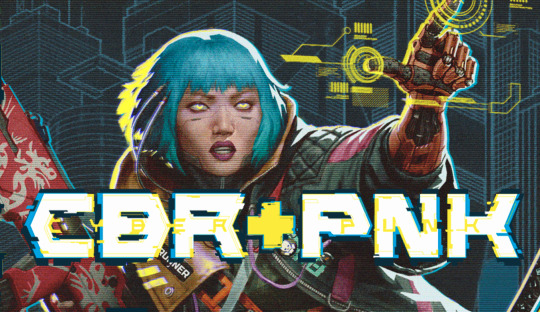
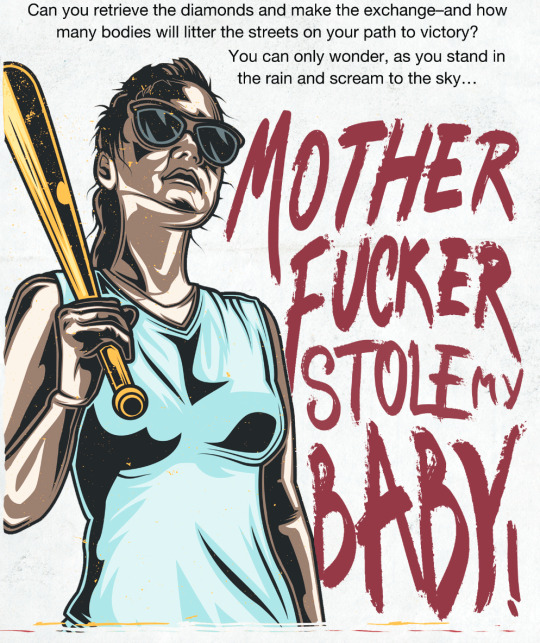



Android Outbreak, by Munuxu.
Android Outbreak is a quick, skill/luck-based TTRPG that will have players taking the roles of escaped androids racing and battling their way towards an evac point on the other side of a megacity that is raised high in the sky above a burning miasma that's taken over the planet.
Character creation is sleek, requiring one choice and a a roll or two to determine what your strengths are and how you are unique. Your goal is simple too - you just are trying to get out and get away. The game page itself is part of the rolling mechanics, with the lines on the page used to help measure at what distance you are throwing your dice onto the table. The GM is responsible for creating androids to pursue you as well as other obstacles such as weather events or events obstructing the streets. If you want a game that combines throwing skill with random chance, I recommend Android Outbreak.
Operation Final Monarch, by poorstudents.
A one-page espionage TTRPG in an alternate history 1940's. Assassinate Aleksander Von Korte on his opulent airship, The Watchful Luftrahmer.
Operation Final Monarch is a one-page Tabletop RPG for 4-6 players. One player will act as the GM, providing obstacles, portraying passengers, and describing the Watchful Luftrahmer. You play as Infiltrators, spies from the fallen countries around Arstarkan. Your final mission is to kill Aleksander Von Korte.
When situations get risky you gamble with danger and can always push your luck to try to succeed in any situation. Be careful not to roll a 1 though, as a devastating consequence will soon follow. Use can also use your leverage over the passengers of the Watchful Luftrahmer, asking them questions they don’t want to answer or enacting your special abilities.
Operation Final Monarch provides you with playbooks, which is one of the easiest ways to make the game little to no-prep for the players when they sit down to play. It also gives you a very specific goal - that of assassinating an important political figure while aboard a blimp. The setting is semi-historical, giving the players a frame of reference, but spices it up with elements like Machine Priests and steampunk technology.
Mechanically, the game uses a gambling mechanic that involves the GM rolling 1 dice publicly and 1 dice secretly. Players have to judge whether or not they can beat the total difficulty, and decide whether to Push or Call. Pushing gives you an extra dice but worsens the outcome should you fail, while Calling leaves the outcome up to chance, but minimizes consequences. One of those consequences may be revealing a character secret, which makes your character vulnerable, but also provides other characters the opportunity to help. I think the succinct way the game allows you to dive into character backstory as you are playing the game makes this a prime candidate for one-shot play.
CBR+PNK Core, by Emanoel Melo.
In CBR+PNK (Cyber plus Punk) you play as a team of RUNNERS—mercs, criminals, activists living on the edge and running in the shadows of a gritty, ultraviolent world.
In each game we play an entire new cast of characters making their LAST RUN.
CBR+PNK runs on a super-condensed version of John Harper's Forged in the Dark system, specially tweaked for action-packed ONE-SHOT sessions.
CBR+PNK is well known for its friendliness for one-shots, stripping away a lot of the mechanics that give Forged in the Dark games weight and length. The game is packaged into pamphlets, which means you can hand out only what is relevant to each person at the table: the GM pamphlet for the person running the game, and the character pamphlets to folks who will be playing characters. There are additional supplements that you can add to the game to alter or edit your experience.
The player pamphlet has two columns where you enter all your information, one column for character creation instructions, and a number columns with help and player instructions that you can use as a reference when you come across the relevant rule in play. The GM pamphlet takes a little bit more time to familiarize yourself with, and I think this game will be a lot easier to pick up if you’ve already played other Forged in the Dark games. That being said, this game has won a lot of awards and recognition for how concise it is, and I think it’s definitely worth checking out.
MotherFucker Stole My Baby, by Brabblemark Press.
MOTHERFUCKER STOLE MY BABY! is a quick-play roleplaying game inspired by Cradle 2 the Grave and other action films.
You're a jewel thief - and you and your crew just nabbed a bag of black diamonds for a mysterious employer. You hand the jewels over to your fence for appraisal and kick back for a well-deserved party. Then comes the unexpected double whammy…
Gangsters robbed your fence and swiped the diamonds - and your only child has been kidnapped by the billionaire that you stole the diamonds from! Can you retrieve the diamonds and make the exchange - and how many bodies will litter the streets on your path to victory?
You can only wonder, as you stand in the rain and scream to the sky… MOTHERFUCKER STOLE MY BABY!
The genre and tone of this game are immediately understandable, and it shouldn’t take any time at all to communicate to your players exactly what’s going on in this game. Character creation is very simple - one of my favourite parts is that you circle three items from a list of possessions on your character sheet, and also that your character sheet looks like a Wanted poster.
The game itself is styled after Lasers and Feelings, with a single number representing your strengths, and your successes depending on whether you roll above or below the number. The game also comes with some d6 tables to help the GM craft scenes as you play. There’s also some very succinct but very helpful pieces of GM advice in the GM section, that I think will help you deliver a short but sweet experience for your players.
The Fall of House Prosh, by NotWriting.
The Emperor Hakkan VI has died without an heir. The Imperial throne world Lecatom Rex is empty. The previous Stewards of the throne, House Kotar, are leaving in shame. Their rivals, House Prosh, have ascended the other noble houses as new Stewards of the throne and the Imperial palace.
Humanity lives on a thousand worlds. Star Witches fold spacetime to navigate the cosmos. Noble houses settle conflicts through duels. Prophecies and portents guide politics and religion. And now noble houses whisper of war and secession.
A thousand years of peace are in jeopardy.
The Fall of House Prosh is a sci-fi tabletop RPG about noble tragedy and melodrama inspired by stories like Dune, Shakespearian plays, and Game of Thrones. Players take on the role of characters within 3 factions: the powerful House Prosh, the maligned House Kotar, and the servants of both these houses.
The Fall of House Prosh is a narrative guide through a story of tragedy and politics, where only one house can survive. You cannot decide who falls; you can only decide what that fall looks like. Players can choose to embody the members of House Prosh, House Kotar, or the servants of the two, with at least one character from each faction required to play the game. Each faction has their own special moves, half of which can be employed in the Day phase and half which can be employed in the Night phase. Over the course of the game, you add tokens to each houses’ tragedy pool; those tokens are then spent to carry out moves against each-other.
If you want a game about tragedy and epic stories of loss, you want The Fall of House Prosh.
The Family Rat, by V2S Games.
ONE OF YOU IS THE HEAD OF AN ORGANIZED CRIME FAMILY.
The rest of you are 'friends' or members of the family, who will be forced to decide where your loyalties lie. Who can you trust? Who'll be left standing? How will the family survive?
The Family Rat is a Tale of 21 and a hack of The King's Poisoner. It's a one-page tabletop roleplaying game for 3–8 players, which can be played with a deck of regular or virtual playing cards OR two ten-sided dice (2d10).
The Family Rat uses blackjack hands to navigate a story that carries the themes and vibes of the Godfather movies, setting up one player as the The Boss and the rest of the players as members of the Family. I think this game could be classified as GM-less, because even though the Boss has a different roll from the rest of the family, they’re still a solo character, which I think is an interesting format in which to couch this story.
Over the course of three acts, the family members will decide to make requests, moves, and suffer the consequences of their actions. The Boss enters each round with a significant advantage with their Blackjack Hand (having one card hidden from the others, and winning ties), and uses special mechanics at the end of the final act to dictate the actions they’ve taken for the good of the family.
This is a game with a winner and a loser, but I feel like it oozes with the same charms as the original movie. None of you are great people, and all of you have chances to pursue personal goals and leverage favours or debts against each-other, but at the end of the day, you’re depending on the heart of the cards to decide who comes out on top.
24XX - The Deep, by Chaosmeister
ONE DAY THE OCEANS DROWNED THE WORLD. Humanity survived below the waves. The sea birthed leviathans. Your crew owns a dingy old sub. Odd jobs, salvage, leviathan hunting and a few merc gigs keep you afloat and breathing.
I’ve played 24XX games a couple of times and all of the ones I’ve played before are definitely one-shot friendly and require minimal prep. Players choose a character class or type, and get everything associated with it, along with a few key choices like gear or background to flesh them out a little bit. All in all it can take as few as 5 minutes before you start play. The games also usually come with a bunch of roll-tables that give the Game Master interesting encounters, obstacles and goals without having to do a lot of prep. You can also easily condense an adventure into a couple of hours, making these ideal low-prep one shots.
What I like about The Deep is the setting. It’s an excellent example of how you can bake in unique setting elements in just a few roll-tables - for example, are you working for a genetic research & development group or a mining corporation? Does your submarine have giant claw markings from various dives, or a mural of a sea god that has importance to you? If you have a repelling electric net, what kinds of animals are you repelling? These kinds of details infuse the setting with flavour, which I think can really inspire and entice the people at your table.
Other Games I’ve Talked About Before…
Something Is Wrong With The Chickens, by Elliot Davis.
Faewater, by A Smouldering Lighthouse.
The Children of Saturn, by Dan John Crowler.
Subway Runners, by Gem Room Games.
Gay Crime: Sapphics Against Capital, by Evey Lockhart.
Spirit Line, by Jhryne.
Cryptid TV, by yahahn.
Lady Blackbird, by John Harper.
#low-prep#no prep#one-shot games#tabletop games#indie ttrpgs#game recommendations#dnd#asks#indie ttrpg
98 notes
·
View notes
Text
OC Incubators: TTRPG Design for Making Cool Little Guys
I've been thinking a lot about why some people like to play Certain Games and how that intersects with action figure style play and the desire to make your own little blorbos.
What is it about Certain Games (which will not be named so I don't go down a rabbit-hole of breaking apart that game's design lmao) that really gets people's sitting down and just making a whole bunch of cool OCs? You know, your zany wizards, sexy demony bards, and all of that.
So, I've talked a lot about this with some people (shoutout to @temporalhiccup), and I'm not the only person to be thinking on similar wavelengths (check out this fun read by @sprintingowl), and in those discussions and in that reading, I've put together a few what I think are Key Ingredients for making ttrpg that is also an OC incubator. At least, in the sense of how I would want to do it.
So first, what is an OC Incubator? My definition is basically any sort of semi-sandbox/open ended game where you make your own cool character and then go do cool things. Along the way of doing those cool things, you come up with cool stories and have your OC evolve in even more cool ways. Cool, yeah?
Here are the key ingredients I've identified for the incubator stew (store bought is fine);
Character Options
Character Potential
An Inviting Sandbox
So let's break these down a bit more below;
Character Options
Character options is the most straightforward of the points. You need interesting and fun options - building blocks - for the players to craft their little guys from. Options that are exciting and easily communicate their core identity quickly.
A lot of this is walking a fine balance of providing enough options that making a choice is exciting, but not too many so as to be overwhelming.
But ultimately, these options are there to hit the dollmaker, picrew, character customization screen, itch. It should be fun to make all those decisions.
Aside: I gotta do more stuff with lifepath systems.
Of all the main ingredients to our incubator, character options are probably the easiest to come up.
Character Potential
This is where things start to get a little more complicated. Potential is all about aspiration. It's less about being able to get to that point, but more about "oh wow, look at all these extra things my cool OC could do".
These options are something to look forward to, something to think about. Neat cool extra doodads for making your cool little oc even cooler and expand on your cool little oc's story like milestones and growth.
In a lot of ways, these sorts of options are just an iteration of the initial character options you use when making your character. These are probably going to expand on core elements of the character options (class or playbook abilities, etc).
Again, the key point is potential and aspiration. To make you think about the future of the character.
I think, ideally, a game is intrinsically rewarding to play. You play it because its fun, not to get some sort of external reward. Play to play. But it also can be fun to put some carrots on the stick.\
As a treat.
Inviting Sandbox
The setting and premise of the game needs to invite players in. It's the big fancy dollhouse for all your cool toys. There needs to be space to play in it, but also there needs to be something to still play in! Some games are operating at an advantage: with well established settings that have been around for years and/or using a setting that utilizes tropes and ideas that also have been established for years. You know. Elves and stuff.
But! You absolutely do not need a well established setting or play with well established tropes to make an inviting sandbox! The main criteria is that it is inviting. Whatever that means to you, go for it. For me, an inviting setting, one that would make me want to play around in, needs;
Enough foundation to guide the play. What are the major players and assumptions of the settings? Give me the overview and broad strokes first!
Enough space for the table to add to while they play in. If every thing is set in stone, then what are we playing in this sandbox for? You need some sand to sculpt! Put some sand in your sandbox!
I could spend a lot more time talking about settings, sandboxes, and how it all circles back to anti-canon, but that's a story for another post.
Mixing It All Together
So, with those ingredients identified, how do you go about layering them all together? How should they interact with each other? And the easy answer is "I don't know, figure it out."
But also, I don't entirely know. You gotta figure that out for yourself. That's part of the design process. I don't think there's one singular way to "design" around getting people to have fun whipping together some cool OCs and then playing around with them together. In many senses, you can do that in practically any game. But for some of my current projects, I want to try keeping the three ingredients in mind as I write the games (particularly Furry Crime Game), and see what happens. Maybe it'll end up hitting the notes I want it to - crafting a game that makes the players constantly rotate their cool little guys in their mind - maybe it'll end up being something else. I dunno, real Ms. Frizzle hours: Get messy, make mistakes.
Also, as I'm writing this out now, I think a potential fourth ingredient to try mixing into the stew is Player Investment. Time, creativity, emotional. It all feeds into the character and different games expect different levels of investment. Something to probably keep in mind while you hone your game.
I don't know how else to end this, except to say that I'm excited to experiment in this space. Maybe you are too?
#indie ttrpg#ttrpg#ttrpg design#could probably spend more time on this#but done is better than perpetually a draft
425 notes
·
View notes
Text
Perfect Draw
Shoutouts to this being one of my favorite queer developed TTRPGs in a while and it only fully came out after I had chosen my pride month line up
Touchstones: Yu-Gi-Oh!, Cardfight Vanguard
Genre: Card Game anime, Shonen
What is this game?: Perfect Draw is a tabletop rpg about card games and the kids who play them
How's the gameplay?: Perfect Draw is a powered by the apocalypse game, more info on that here, the narrative bits have some interesting mechanics that play into other systems, but that's not really why you're here. While Perfect Draw's narrative roleplay systems are certainly competent and fun, the REAL meat comes in the form of its extensive in-depth combat system. Players get to build their own deck of custom cards, using either custom or pre-made effects, and get to duke it out in a simplistic albeit very fun TCG, a major thing in the game design is the idea that Winning will always be a hard bargain, and sometimes winning might be the incorrect choice!
What's the setting (If any) like?: Perfect Draw technically is setting agnostic, but it does have a default setting in Shuffle City, a city inspired by the many different cities in Yu-Gi-Oh (Domino City, Heartland City, arguably Neo Domino from 5ds?), its a large city with many strange and unique characters, and a strange underbelly of mystical powers fighting each other for power! Perfect Draw's setting is very loose however, only really requiring the vague idea of magic (kinda) and card games to really get started.
What's the tone?: Perfect Draw often has the tone of the anime its based on, high action friendship-fueled powers abound! It's very cute and optimistic, but I've seen darker games work decently well
Session length: Combat can take a little bit, but 2-3 hours is realistic
Number of Players: Perfect draw is, very deliberately, built around smaller groups, 4 players (including GM) is advised
Malleability: As said above, PD does not have a setting, you could theoretically run anything within it!
Resources: This is sadly where the game falters a bit, right now there's a few unofficial Tabletop Simulator add-ons, but that's about it, there's also an official card maker, a card balance calculator, and a few homebrew playbooks, also there's a huuuuge sheet of community made keywords for cards (some of which are written by yours truly!)
I'm a MASSIVE fan of card game anime, they're just so genuine and silly in ways that not a lot of media nowadays is. so seeing a game that appeals so much to me was a godsend! It's a fantastic game made by fantastic people, and I highly recommend it
68 notes
·
View notes
Note
youve mentioned offhand ur issues with thirsty sword lesbians, have u talked at length abt this somewhere before and if not do u want to? i want to hear ur thoughts hehe
now before i get into this i want to clarify: i like thirsty sword lesbians, overall! i think it takes some of the best stuff from monster hearts and refines it -- i think it does great and exciting things with pbta playbooks -- i think anyone making a pbta game should check it out because it's full of valuable ideas -- and i've had a lot of fun playing it!
however, i think it's just as flawed as it is brilliant. there's a few different flaws but the biggest one for me is a catastrophic clash between two things the game is trying to be. one on hand, it wants to be a catradora rpg. there's no shame in that, i love games that wear their influences on their sleeves--TSL¹ wants to be a game about kissing your rival after you've both been disarmed, about having a fraught and complicated relationship with your girl best friend who abandoned you to serve the dark lord, about having homoerotic sword duels where your blades lock and you stare into each other's eyes for just one second too long before one of you kicks the other in the chest. i think that's an admirable goal for an RPG and one that TSL hits a lot of the notes of--the fact that the move to "Figure Someone Out" has special questions you can only ask someone when you're duelling them is incredible design. the Strings system, adapted from Monsterhearts, the ability to fluster your enemies when you use the Entice move, the constant focus on what characters desire and how their actions conflict with those desires--so much of the game is working towards that!
unfortunately, the game also wants to be about queer resistance to homophobia and capitalist/imperialist hegemony. this is clear in its sample settings, with their eyerollingly on-the-nose conflicts like defending 'queertopia' and fighting the evil sorceress 'repressia'. but much more importantly, it's clear in the game. several of the playbooks are defined by their relationship to sexual hegemony--the beast is about someone who is othered and monsterised for expressing their existence and the seeker is about someone sheltered and prejudiced moving past that and discovering themselvs and others. like, it's not subtle--
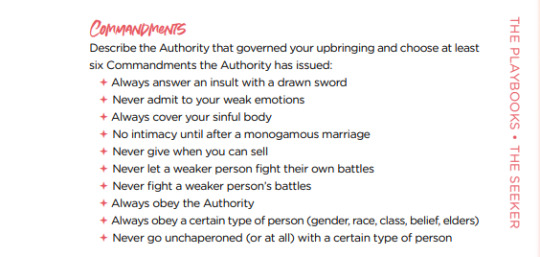
and to be clear, there's nothing wrong with that, either. just as i like a lot of TSL's swashbuckling girl-romancing flirting-at-swordpoint mechanics, i really appreciated how (although the game's outlook on what these forces are is predicably liberal and its tonal approach to these things is one that i personally find teeth-grindingly insufferable) these things are actually integrated into its mechanics. playbooks like the beast and the seeker (and the rest!) imply something about the world the game is set in and its sexual politics. this game is meaningfully queer in the way something like dream askew is, in that its mechanics ask you to actually explore your character's queerness specifically. this is good, and it's something that elevates it above about 90% of ttrpg stuff that sells itself as queer.
so if both these things are good, what's the problem? well, it's that they're two great (or at least--interesting) tastes that go fucking horribly together. the fundamental problem that i have with TSL and one that i think takes a lot of work to get around in your own campaigns is that it simultaneously wants you to be fighting (on the individual level) a lot of antiheroic ultimately sympathetic hot girls you can flirt with and kiss--a lot of 'i can fix her's or 'she can make me worse's--and on the broader narrative wants you to be fighting institutional queerphobia (and often, although this is nowhere near as actually supported by mechanics, a more generalized 'imperialism' or 'capitalism' or 'bigotry'). so you end up fighting 'those stupid sexy homophobes'--people who are according to the text (not just 'lore', but the rules text, the mechanics you're playing with!) simultaneously the violent enforcers of cisheteropatriarchy and a bunch of fuckable lesbians with sympathetic backstories.
& i just think those things are fundamentally at odds. the result is a game that if you try and play it at face value works at cross purposes with itself, attempting to do two perfectly valid things without considering what happens when the streams cross.
it also has a few other flaws--like many other PBTA games, its balance falls apart if you play any long campaign (my group and i had to figure out special alternative level-up rewards!) but it comes with no inbuilt way to neatly conclude a campaign or character. its tone is something that, as i often mention, i absolutely cannot fucking stand--it has a certain sense of humour that feels profoundly dated to me and was never my cup of tea when it was in vogue. this is something i try not to hold against the game bc it is very much a personal taste-level 'cringe' reaction but the game lays it on pretty fucking thick.
more to its detriment, it is profoundly, gratingly liberal in the exact way people who deploy that tone usually are. its understanding of anything outside queerphobia specifically is just a purely aesthetic & thoughtless 'imperialism is bad!'. it manages a more nuanced understanding of homophobia, but it only manages it on the individual level--for a game about queerness and about fighting systems of cisheteronormativity, it has no systemic or material understanding of these systems and no interest in establishing one.
and finally--and this is just one paragraph but it's so fucking awful i feel the need to complain about it here because i think about it often as an example of something i never want to write:

this sucks! real bad! so deeply fucking silly to reassure people in your game that you called Thirsty Sword Lesbians that it's okay if you want to be cishet. like, it would be one thing to make a game where you can neatly extract the lesbianism and have the same game, a surface-level aesthetically queer game with no actual interest in queerness except as a marketing term. it would fucking suck but this paragraph would at least describe such a game. but TSL isn't that!!! . 'thirsty sword cishets' would be a very different and much worse game! awful and self-defeating paragraph. deeply silly concern to address and give airtime to. i didn't buy a game called 'thirsty sword lesbians' to be told 'its okay to be heterosexual i pwommy'
so yea just to reiterate: i like the game overall, i think there's a lot of good valuable stuff in there designwise despite all this. but i'm very ambivalent about it--ironically, i feel a love-hate relationship with this game about love-hate relationships. i admire it and yet i despise it! i long to put it at the tip of my sword and slowly tilt its cover up so that the pages look up at me coquettishly but with burning anger in their page numbers. if this book was a person id hatefuck it, is the joke, thats the joke im making, here, in this post. thanks
¹ i call it TSL whenever i can because the name 'Thirsty Sword Lesbians' makes me cringe out of my fucking skin. genuinely horrible name. i'm sure it's funny the first time you hear it, i got a mild chuckle the first time i heard it to, but it's such an obnoxious thing ot have to say repeatedly when seriously discussing it. should have stayed a placeholder name amiguitas
222 notes
·
View notes
Note
Anyways, I gotta get back to work soon, but how about I offer a quick detox? If you don't mind, could you share a story of a time that you were playing a TTRPG and it just worked, exactly like it was designed to work, and everything was perfect - I'd prefer if it was a D&D 4e story, given the context, but I'd love any story.
Sadly, as much as I would love to share a 4e story, the truly sublime RPG experiences I have had have been in completely different systems, which I have mentioned in other posts of mine!
The first one was my run of running a one-shot of Best Friends set in a Finnish gymnasium (school equivalent to, uh, high school, upper-secondary school) with the main characters being second year students. The big crowning moment of second year of gymnasium for many is a tradition know as "Wanhojen tanssit" ("ye oldes' dance" for lack of a better translation) which is kind of like prom in its social significance but is more like putting on a nice show for the parents where the kids dance together in fancy outfits. Anyway, it was the PERFECT framing for a fun coming-of-age story which covered all of their second year, and it had everything! Drama, romance, petty arguments, two of the girls realizing they were gay for each other. It was so sweet. (Oh and of course two of the girls ended up dancing together with the other one putting on a suit and basically butching it up, which given that this was early two-thousand-and-tens would have actually been eyebrow-raising had it happened irl, it was incredibly cute.)
The second was a convention game of Monsterhearts and it was also an absolutely sublime experience. It was a very fun group, with everyone in the group being at least ostensibly cis guys (I wonder what happened to the rest of them? Anyway), but everyone like being immediately on board with the idea of playing out a story of summer camp with a bunch of teenage disaster bisexual monsters. The player who picked the Mortal playbook for his character had played Monsterhearts previously and knew exactly what he was doing: a Mortal in a Monsterhearts game is basically a ticking time bomb, and his character started immediately pulling on as many heartstrings as possible. The game ended with the summer camp center on fire and almost the entire cast of characters dead. My werewolf boy and the witch girl were the only survivors and they dramatically walked away in silence (with my character in wolf form).
During the denouement the MC commented "oh and I didn't even have to use the big monster in the lake." That immediately sold me on the system. Our characters had become the only antagonistic force the game needed, with no need for the MC to do anything besides watch the sparks fly.
36 notes
·
View notes
Text
simplicity in design is a virtue, you cretins
i'm rereading Avery Alder & Ben Rosenbaum's Dream Askew / Dream Apart in preparation to finally do some serious editing of my game of intimacy, liberation, and faggots at sea Beneath Pirate Flags. among the billion other small things i'm reconsidering as i go over the bob/ndnm fundamentals, i'm really struck by how simple both these games are — elegant in a way i think i really failed to capture in the first public versions of bpf.
i have a theory about this, and it has to do with why i think the sprawling "always another sourcebook" approach taken by a lot of dungeons & drasprawling, commercially successful ttrpgs is fundamentally weak design — but first, here's one of them fancy 'keep reading' buttons you can click on to keep this post from being six and a half miles long.
hey, welcome back. lets get into the details:
bpf makes a critical break from the original ndnm games in the way its environmental playbooks work. mine are things like "the fort" and "the map" (see images) — individual iterations of broader concepts, much like the character playbooks ("legend", "dandy", "monkey" etc) are iterations of common pirate types. there are, almost certainly, multiple "monkeys" in one world — much as there are almost certainly multiple forts.


this contrasts with Askew / Apart's setting books — things like "varied scarcities," "society intact," and "goyishe world." these are intentionally broad environmental pressures. although "society intact" may be encountered different times in different places — with different names and different faces — it is, fundamentally, the same force.
2. this isn't necessarily a thing i want to change (although there are tweaks i'll be making to just about all the playbooks) but it is real interesting to think about how bpf got here, from a design perspective. the story is simple: bpf didn't start from playing either dream. it started with me reading wanderhome, and this design is borrowed (nearly) directly from there.
wanderhome, like bpf, has players create new environmental elements again and again over the course of a campaign — from the smallest kith to the largest citadel, you might be doing generation multiple times in a single session. wanderhome handles this by simplifying, simplifying, simplifying — a trait has one picklist, a nature two, and so the process of generation is quick and nondisruptive, and you're quickly able to create a populated world without losing yourself in any particular moment of generation.
(che, i hear you shouting, you baited us in with an inflammatory claim about d&d's bad design. get to the point already. ok. i will)
one of the things i like most about possum creek games as a whole (ha, got you again) is the way they can become sprawling without ever overwhelming players. this has been talked about a lot in advance of the yazeba's release — but it's true for wanderhome, too.
where both dream askew and dream apart have just six setting elements, wanderhome has (even if you disregard the seasons and holidays) a whopping forty-eight traits and thirty-six natures. it is — despite seeming small in the shadow of yazeba's — a sprawling game, and it's only through a tremendous efficiency and elegance in design that the whole thing doesn't come bursting apart at the seams. some of that is thanks to the ndnm token economy as a whole and some of it is good writing specific to wanderhome, but none of it is possible without an ethic that prioritizes simplicity — cutting the building blocks into their smallest fundamentals, so they can fit into something huge and, more importantly, comprehensible.
this all stands in sharp contrast to what seems to be the tendency in dice- and percentage- based games (told you i'd get there eventually), who — out of a need for a bespoke, simulationist tool for every situation, maybe — have a tendency towards appendices, supplemental books, and a proliferation of minutiae. i am talking about d&d here, although i don't think it's the worst offender — i still have nightmares about the hand-to-hand system from top secret, a game my dad only recently admitted he was "basically only pretending to understand the rules of" when he ran it for my friends and i when we were kids. i'm not saying all crunchy game design is like this — honestly, i think crunchiness is a totally different spectrum from rules-complexity — but i do think that, sometimes, in an effort to feel sprawling and more importantly substantial, games become inefficient and more or less illegible. it is hard to play d&d. it is hard to hold all those rules in your head. by comparison, dream askew, dream apart, and wanderhome can held pretty easily in your head. you could probably even reconstruct some of the playbooks from the design fundamentals (act weak = gain token, act strong = spend token, evocative picklist). the most important thing about these games is that the rules are evocative and they let you stay in the fun part of play for as long as possible, interrupted as little as possible.
let me make this totally clear: the fun part of a game can absolutely be tallying numbers and consulting armor ratings, but i don't think that's the reason some of these games get so big. the real answer is: cutting shit is hard! eliminating systems is hard! saying "this is not helpful, let it go" is really tough, especially when you're left with a design document that was shorter (and by extension, whispers the awful voice in the back of your head, worth less) than you were expecting. still, it's important to remember: 'good system design' is not the same thing as 'filling as many pages as possible.', even if that's hard to accept in an industry that feels like it has to be prices and paid by the page.
how does all this affect beneath pirate flags? well, that's simple — pretty quickly in my recent playtesting, i realized that pausing mid-session to create new maps, forts, ships, and so on sucks ass. it's fun to brainstorm with friends, but the environmental generation throws off the pacing of sessions in a way the wanderhome kith stuff just doesn't. why? there's too much shit in my environmental playbooks! wanderhome has two picklists per nature and one per trait. askew & apart have just one per setting element — and you only have to do it once per campaign. beneath pirate flags has five. five! it sucks! and cutting out that unecessary shit — even if i do want to straddle the middleground between dream askew & dream apart's simplicity and wanderhome's sprawling growth — is going to be the hard first step on the long road to getting this game where it ought to be.
#ttrpg#ttrpg design#wanderhome#dream askew#dream apart#beneath pirate flags#gay pirates#rant aside i am really eager to get back to working on this game#it has such good bones but its gonna be a long road to being done with it#no dice no masters#belonging outside belonging
164 notes
·
View notes
Text
TTRPG Read-Through: Patchwork World
Here is a read-through I did last year (originally posted on Twitter) of one of the most unique PbtA games I've ever read: Patchwork World by Aaron King! - Christian
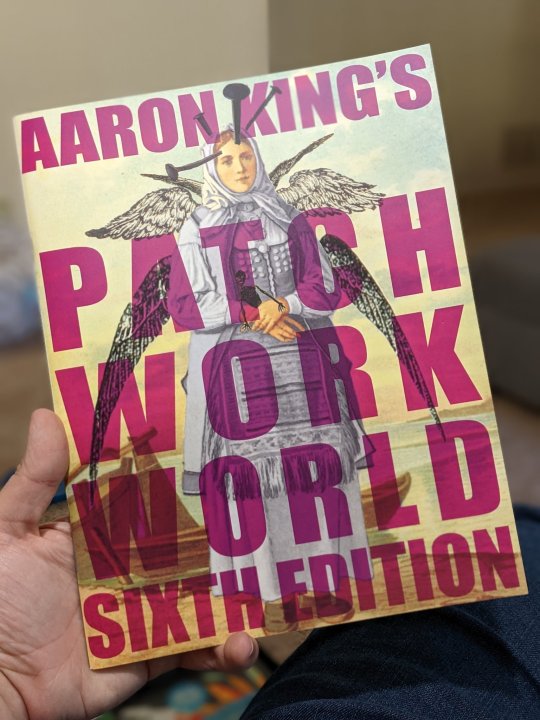
Credits up first. I know a lot of these folks and they are really cool! Excited to dig into this. I've heard good things, and it's been a while since I've read or played any Powered by the Apocalypse.
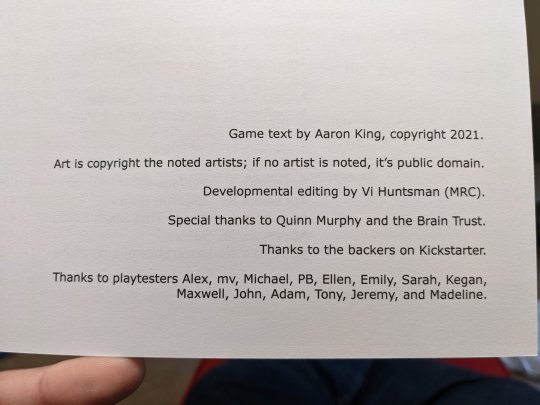
This is a cool, strong set up for me. I really like settings that ask characters to face a changing world and either take up change themselves or work to restore the old way of things. It's a headspace I find myself in a lot IRL these days so it's fun to explore.

I'm interested to see how the no stats, no playbooks angle of this game works, considering playbooks are typically such a staple of PbtA games.
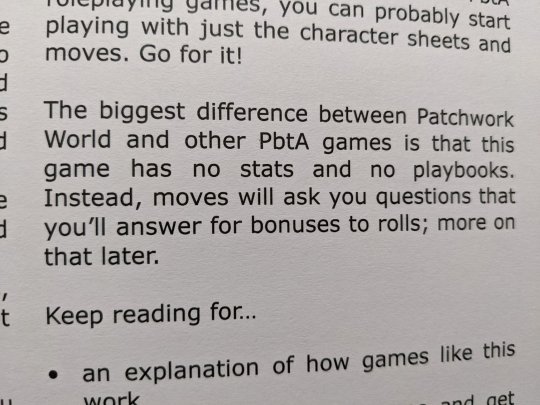
Standard three-tired success, mixed success, fail forward resolution for rolls here and questions on the moves determine your bonus to the roll. Easy peasy. +2 is the max bonus.

Other types of rolls are described here. Interested to see how they come into play. I also love clocks and use them in pretty much every game I run so it's nice to see those laid out here too.
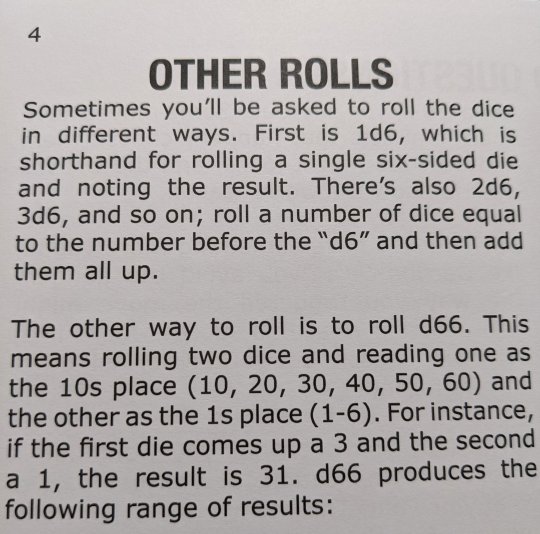
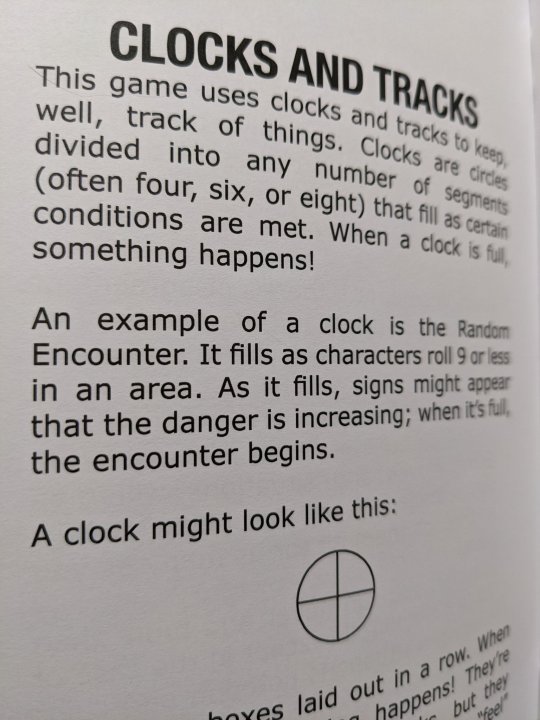
We just love a lil guy, don't we folks?
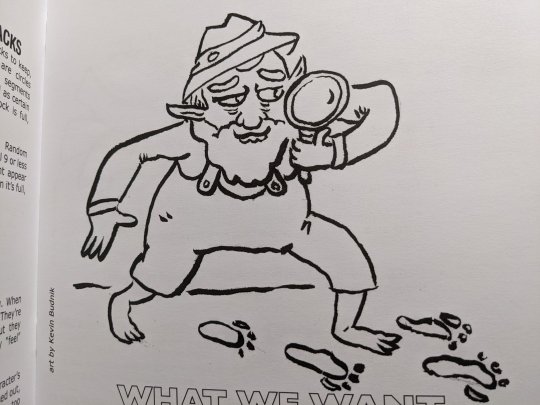
A good chunk of the opening here is spent on laying out a lot of solid foundations of roleplaying generally. It feels like a book (so far) that would work for entirely new players. It doesn't feel essential for me, but I never mind a game that supports varied experience levels.

Character creation is wide open, especially since there aren't playbooks and the text stresses that character creation is very much worldbuilding because of this. Fate-like concepts and tags are in here too which are things I generally enjoy. I like the Drawback mechanic.
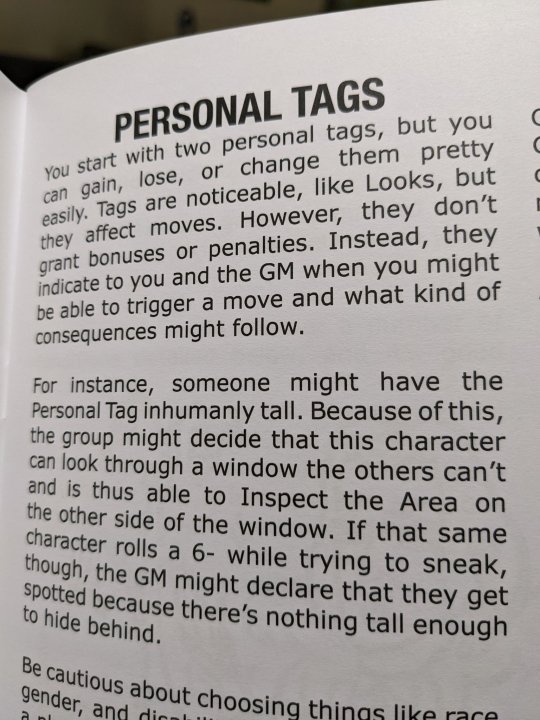
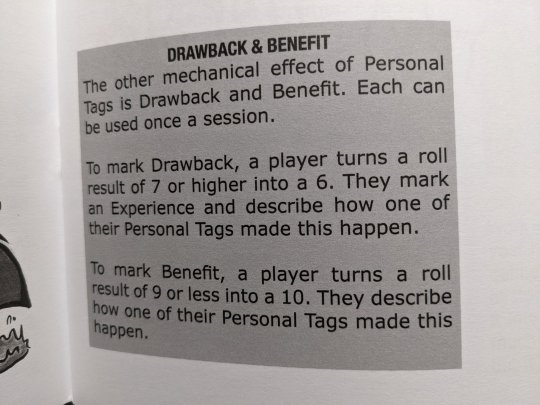
Moves are in the playback I set in the other room so I'm gonna go grab those. You get two chosen moves and everyone has access to a number of default moves. You've got three other life/XP things to keep track of too. I'm especially interested in Hex.

There are a lot of moves! They seem quite varied and often very weird, fitting well with the titular patchwork world. You can have a duck's slick soul to dodge more easily or a magical space suit or speak to birds or be good at cartography. Overwhelming, but in an exciting way.
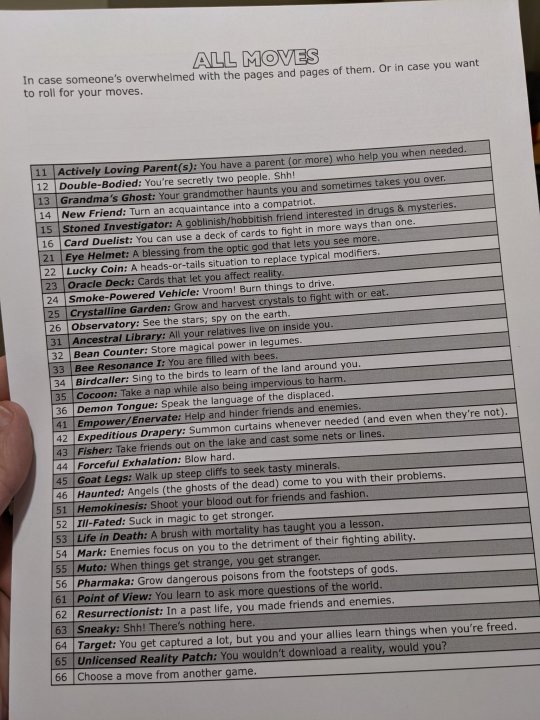
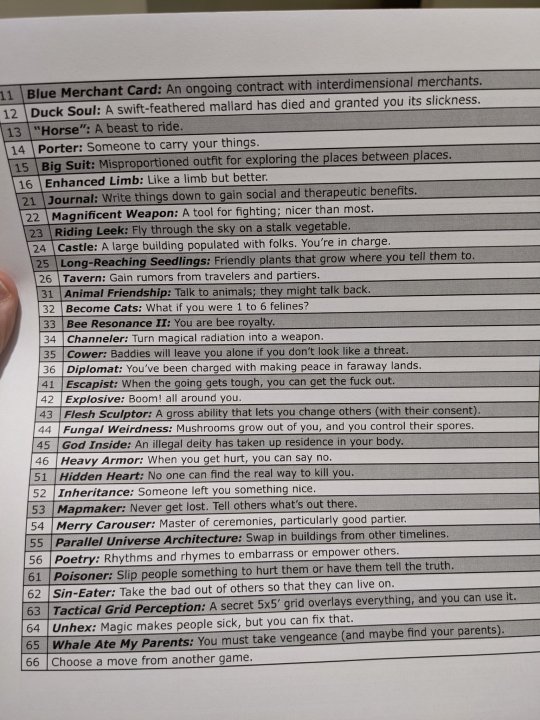
You also choose a community as a party. While PCs all have their original homelands (before the end of the old worlds), you know have a community that gets its own little sheet. This is a cool reshaping of the Gangs from Blades. I also like how the community can change over time.
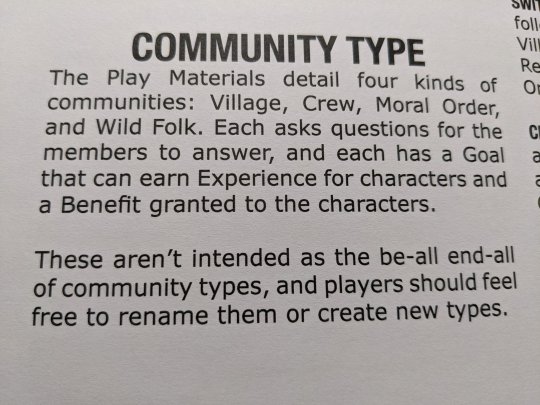
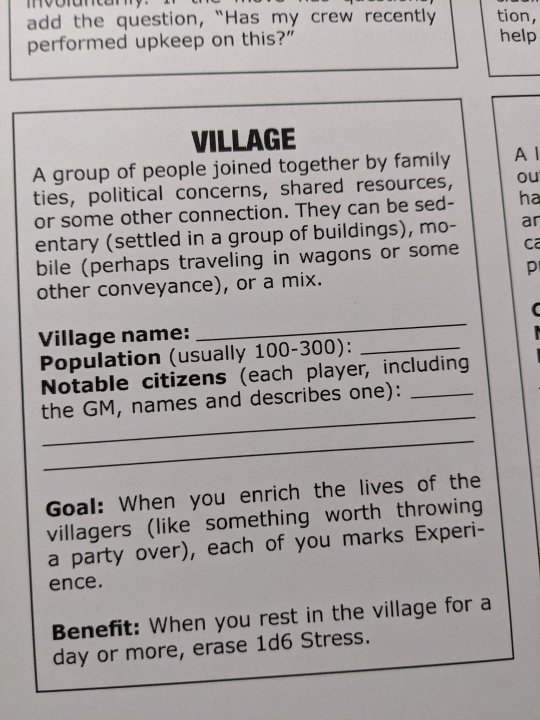
Coming back to a PbtA game after months of more OSR-minded stuff, I think a lot of what these games contain are things that experienced players would say you could just do in any game at any time that it makes sense in the story, but I do find value in stating what's possible.
Esp since many players come to games with artificial limits on their options (whether that's from video games, more traditional RPGs, etc.). I just think good GMing here requires making sure that the players don't limit themselves just to the bevy of explicit options either.
GM moves (mostly to guide the response to failed rolls). I really think the community aspect of this set up is one of the biggest appeals to me so far. That and the wild list of moves, which I'm sure makes for amazing parties of characters.

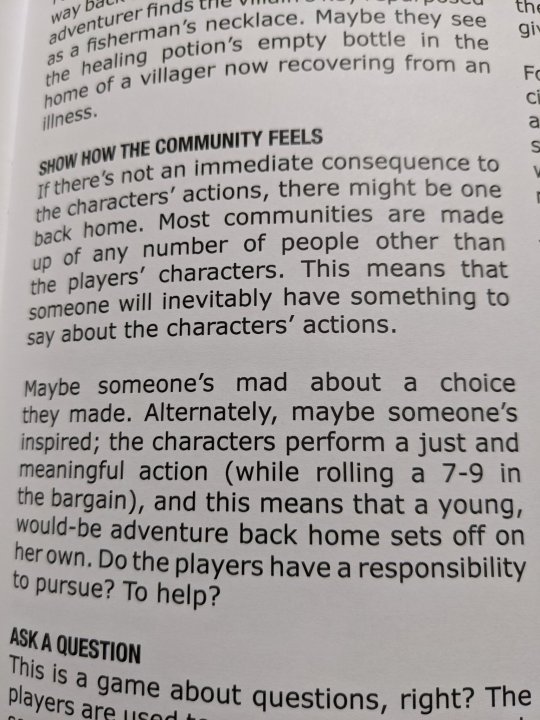
I always feel like it's never something I should be in my own writing (for some probably unnecessary reason), but I enjoy the first-person, casual writing style throughout the book. Makes for a very chill read.
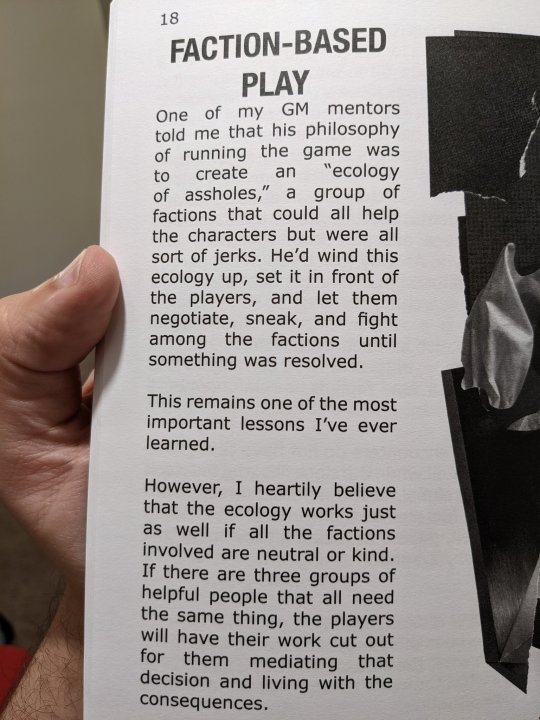
Good to see this game employs the Branson Reese style of NPC naming.

Stress acts as a single catch-all health and challenge rating for NPCs. Ideally, I'd hope this would help lead to the PCs approaching encounters with more than just violence.
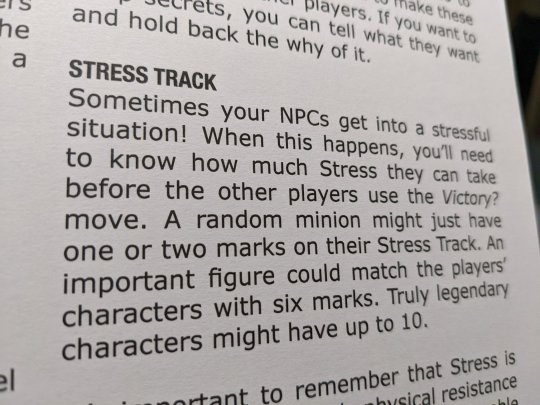
Sections like this are what I'm referring to when I say this book feels very friendly to new players. It's got little anecdotes and thoughts like this throughout.

Look, it's been a while since I've seen A Christmas Story but... it didn't have ghosts in it right?
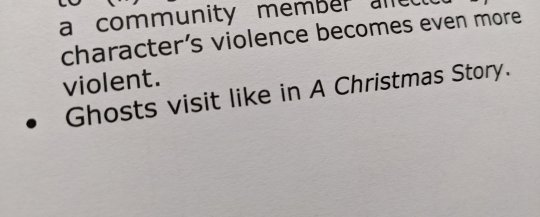
There's a sample adventure in the back (which I'll skip for this read-through) plus loads of random tables. Some wonderfully bizarre stuff in the characters and faction tables. Really gives you a good idea for how gonzo you can go with the setting.
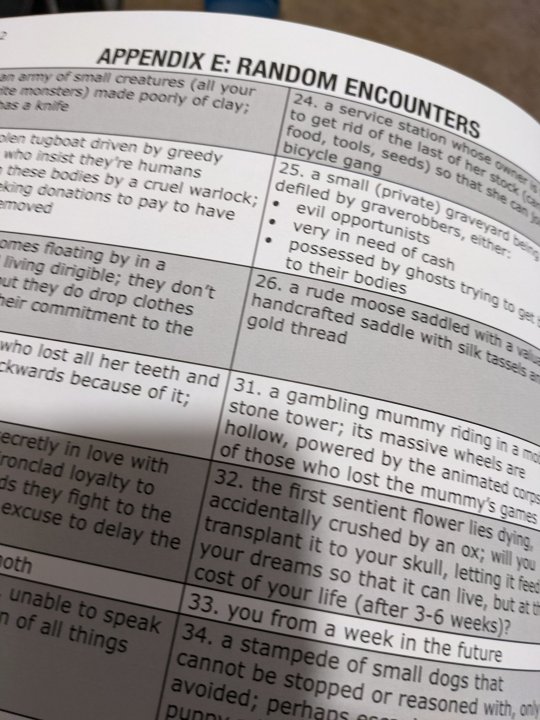
Love these two in particular

Optional rules include hard mode (which I just think is kind of funny to see in PbtA, but could be cool if you lean heavy into the post-apoc setting) and some optional moves. I like that some moves focus on romance, something I enjoy IRL but never think to focus on in games.
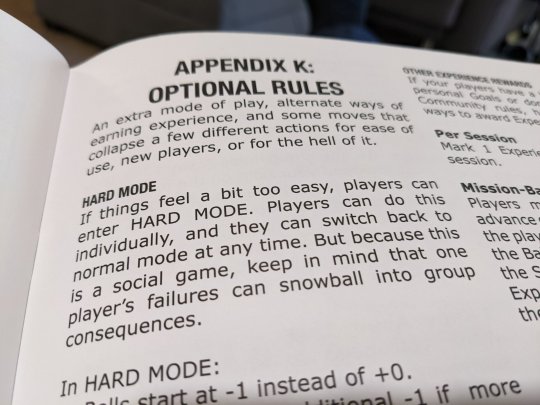
I was wondering why this was the sixth edition!

That's all for the book itself. Going back to the packet to dig into the things I missed. Some expected bits in here but always one or two unique options I really enjoy. Leaking hex is cool (and could have some troubling cascade effects in certain situations).
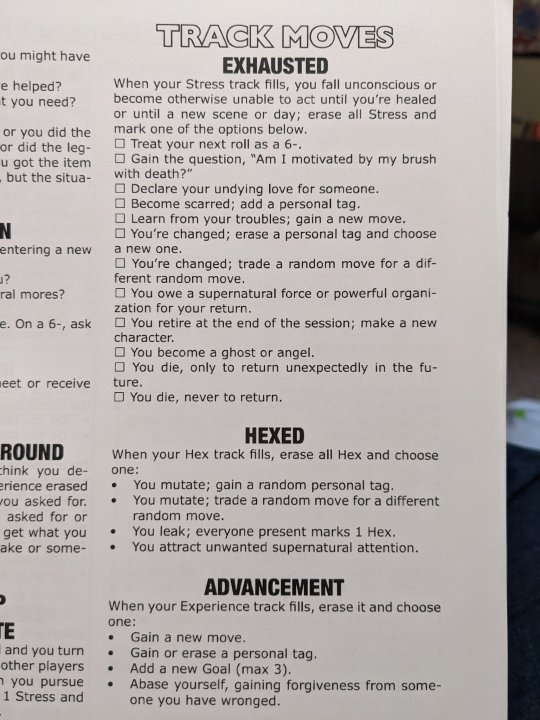
I definitely wish, at least in sitting down to read like this, that the contents of the player packet was also in the book itself. I think PbtA has this tendency of leading to loads of pages on the table, but it can make them very easy to pick up and play or to learn as you play.
That element is definitely here, but I think the vast number of wide-ranging moves and the excitement that would drum up in my player group would more than makeup for that initial overwhelming feel of "whoa, that's a lot of papers out on the table".
Overall, it's the most I've wanted to play a game in this style in a while. I like that the base setup for the world is very much up to the players to determine via the characters they make. I like that PCs here will probably feel unlike any other folks have played before.
The community aspect feels like where I'd want to center my story around, as a player. Seeing that shift and change over time feels like it would be very rewarding and would help lean into the "the old world is dead, what do we want the new world to look like?" theme I enjoy.
Because Aaron King is cool and recently hit a lot of Twitter followers, Patchwork Worlds is now Pay-what-you-want over on Itch.
I'm not sure if physical copies are readily available. For full disclosure (guess I should have said this up front), I got this copy for free from Aaron! Not for the purposes of this thread or anything, just for fun a while back.
Thanks for reading more ramblings from me! If you like to do that sort of thing, check out my newsletter - Missives from the MeatCastle. It's got writings on my work, cool stuff I've run across the web in the last month, and exclusive rpg stuff! https://meatcastle.substack.com
#indie ttrpg#ttrpg#ttrpgs#rpg#fantasy#science fiction#pbta#powered by the apocalypse#aaron king#patchworld world#sixth edition#read through
105 notes
·
View notes
Text
Our Hæth: A Wanderhome ARG
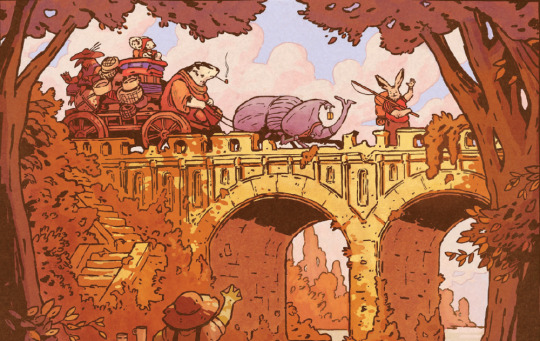
Ok so if you are any sort of game designer, whether that be a programmer for a mobile app, an artist for an indie TTRPG, or a top-tier producer at a AAA-game studio, you should read Reality is Broken by Jane McGonigal, it inspires you to make games that don’t just form digital communities or entertain, but allow a deeper connection to your real life.
And one game that I think, with a twist, could really fit McGonigal’s idea is Wanderhome, the excellent pastoral RPG by tumblr’s very own @jdragsky . This game is beautiful, simple, and a tool for telling these lovely stories about anthropomorphic travelers exploring a recovering society and finding themselves along the way.
Now, let me introduce my idea, tentatively titled Our Hæth: A Wanderhome ARG.
You make a Wanderhome character, just like in a typical game. You also make a separate Wanderhome profile that represents yourself. (this can be your actual Wanderhome character if you want to take on an alternate persona). This secondary Wanderhome character doesn't actually travel the Hæth. They represent your journey in the real world. Your second character's playbook should fit yourself and what you hope to get from this experience. My secondary character will be a Peddler, because I want to grow my personal career.
Then you get connected to a Hæth. These are shared worlds/servers that begin like all Wanderhome games (at the start of Tillsoil very soon after the end of the war) and progress from there. You can start with other players or begin on your own and find others later.
When you wish to travel to a new area, instead of randomly deciding what it should be, you base it on your current location. It can be as simple as your bedroom or as grand as the Great Wall of China! I’ll show you what I mean with where I am now.

A beautiful pond, right? Let’s turn it into a spot in the Hæth! Our first nature is based on a literal take of the area. I’m by a pond, so the first nature will be Lake! The second nature is more metaphorical; based on what you know about your location, choose a nature that describes its personality. A lot goes on around this pond, so I’ll pick Carnival. The third nature should describe the place as it is when you arrive. The calm nature of the pond today means the third nature is Field. Build the location with the rules of each nature, combined with the traits of the season, and you’ve made a Place!
In Our Hæth, each location is permanently saved into the world you created it in. If other players want to visit this location rather than create a new one, they’ll replace the third nature and the seasonal traits and set off! They can see what you’ve written about the place and the adventures you’ve had here. If you know them in real life, you can share what the real-world inspiration is. If not, you can discuss as much about it as you feel comfortable sharing.
Once you're in a Place, great! Start playing Wanderhome. If you're alone, write down what your traveler does in this place. If you're with friends, get together in person and roleplay it out, or chat together over Discord or your online forum of choice. Their characters may travel with you for a while or your paths may diverge and reconnect later. Just remember what happens so you can share it as part of your character's story. When you make a Kith, go through the regular Kith creation process and add them to your Hæth. If other players visit this Place later, they may meet your kith and will want to know what happened.
The other big ARG element of this version of Wanderhome comes with using tokens. When your character does something to create a token, you need to do something to make a token in real life. Have a list of what different actions in Wanderhome mean for you in real life. For example, when my character Camper gives away something he holds dear, that means I have to complete some professional networking. Your token action should be challenging or good for you. Change your token action as your challenges and needs change. Make them fit your life and your goals.
Take a break to complete your token action, or write it down for after the session. You won't be able to spend your real-world token until you complete your task. Once that's done, the next time your character spends a token, you can spend one too! Your token rewards are something positive to reward yourself for putting in the effort and caring for yourself, your relationships, or the world. In my Hæth, when Camper keeps someone safe from the difficulties of the world, I get to take a nap rather than work!
The months can change in small groups when you agree to change them. In bigger groups, you may set a real-world date for the change in the months. Ask the month's question to yourself and your Wanderhome character. Consider your answer a "yes" regardless of which one of you says so. When the time comes for the seasons to change, set up a party with others in your Hæth or throw your own private celebration. Just as the holiday marks a moment of personal growth for your character, take a major step forward with your own goals. As Camper celebrates the new year, I'm going to start searching for a summer internship. I'll adapt my token actions and rewards as needed, and I'll continue playing.
So long as you have Wanderhome, you can play this game. You can keep track of your Hæth in a notebook, on a google doc, whatever. My perfect version of this project would be a little website where players can join different Hæths, watch their world grow on a virtual map, see all the information neatly organized online, and connect to a wide range of people in the Wanderhome community.
Thoughts?
95 notes
·
View notes
Text
Revue Starlight PbtA Playbooks
Hello, everyone! I've moved stuff from the Revue TTRPG onto its own blog, to keep everything neat and orderly.
You might guess from all of the updates I've been writing that I've been really excited to work and think about this RPG. I hope that everyone can look forward to it, and that I can create a system that can allow everyone to create their own Revue Starlight stories with friends, whether with existing or original characters.
The TTRPG will be a Powered by the Apocalypse system, following a long and storied legacy of narratively-focused RPGs that enable robust collaborative storytelling. To help facilitate the portrayal of unique characters, it utilizes what are called Playbooks. (You might consider them an analogue of "classes" from other RPGs, whether on the tabletop or on a video game.) However, these Playbooks don't represent how you look on the outside, or what your weapons of choice might be. Instead, they define a character archetype, highlighting your character's core emotional conflict. For this TTRPG, the question they ask is: "Why did your character become a Stage Girl?"
Playbooks can shift between sessions as your character advances, signifying your character's growth and how a new core emotional conflict may come into focus for them. Stage Girls are too varied and complex to be defined by any one thing, after all.
Here's some examples of some Playbooks I've written up so far! (Everything subject to change.)
The Challenger
The path to becoming a Stage Girl wasn’t handed down to you in your youth. Maybe you discovered it later in life, or your family expected you to tread a different path. You seek to defy those forces who seek to dictate your life’s path for you so that you can take hold of the reins of fate yourself.
You might have a variety of different opinions on the world of theater you’ve found yourself in based on your unique outsider’s perspective. Maybe you aspire to be just like the greats, hoping to, one day, fit in with all of the people you looked up to when you started this journey. On the other hand, you might see the flaws in the restrictive, antiquated system, and aim to prove by example that it can be changed for the better.
Examples of Challengers are: Aijo Karen, Hoshimi Junna
The Exile
You’re running away from something. You were already smitten with theater back then, too, but you were in a different troupe, or maybe even a different country. However, one day, something changed: perhaps tragedy struck, or you failed at the moment when it mattered most. Whatever may have happened, you’ve spirited yourself away somewhere else where no one remembers your greatest shame.
You’re still working to pursue your goals no matter what, but your past haunts you. You’ve found new friends and family, but the fact that the people you left behind are still living their own lives scares you. You might hope to one day reconcile with the people in your past, or perhaps prove once and for all that you don’t need them to live your life.
Examples of Exiles are: Takachiho Stella, Yumeoji Fumi
The Guardian
Though it is you who stands upon the stage, you know that there are better reasons to act than just your own self-interest. You have taken on a Charge, which consists of the people or things you’ve sworn to protect—perhaps the members of your class, a childhood friend, or a memory that’s on the verge of fading away.
If your Charge consists of people, you may sometimes stand behind them to support them. Other times, you may stand by their side to work alongside them. Other times still, you may stand against them—because no one else will help them realize the errors of their ways.
If your Charge is a thing or idea, you’re likely one of its last bastions. It needs protecting—otherwise, you wouldn’t be a Guardian, after all. It’s your reason to be a Stage Girl, and you won’t hesitate to sacrifice yourself to protect it… or, perhaps, others.
Examples of Guardians are: Daiba Nana, Ogami Shiro, Tomoe Tamao
The Trailblazer
Forget what anyone else says about being a Stage Girl—you’ve become one just because it’s fun! Others train day in and day out to be at the top of their field, but compared to them, you live more in the moment. What’s wrong with that? Those stuffy girls with all of their high standards never catch a break, while you spend your time expressing yourself and having fun with the people you love most. It’s certainly more exciting than whatever you were doing before!
However, being a Stage Girl isn’t always fun and games. When hardships arise, you might find yourself questioning why you chose this life without much of a strong external force to tie you to it, relying on only your fickle whim and motivation to drive you forward. You may be searching for such a reason to stay—or, rather, pushing back against those who try to tell you that you need a better one. At times, however, you might ask yourself the most difficult question: is your personality the true you, or just a glib facade?
Examples of Trailblazers are: Otsuki Aruru, Otonashi Ichie
#revue starlight#pbta#ttrpg#dev blog#aijo karen#hoshimi junna#takachiho stella#yumeoji fumi#daiba nana#ogami shiro#tomoe tamao#otsuki aruru#otonashi ichie
46 notes
·
View notes
Note
Hey, do you have any tips for writing modules\adventures\supplements\whatever for TTRPGs?
Not even for the purpose of selling it. I’m just working on a project for fun and have been stumped on actually putting the concepts, hooks, playbooks, etc. into words (I usually just do the illustrations).
Basically anything to help with the writing itself. Like how to make it more evocative, better formatted, comprehensive, & all that.
I live and die by the outline!
Basically, my process for modules for games that already exist (versus writing a new game) is to find a few I like and look at their tables of contents or layout. Let's use Slugblaster as an example here.
I'm working on a neighborhood and want to decide what should go in it. Let's see what the neighborhood in the core book looks like.

So from this page, I see 4 paragraphs of description, a popout box about technology, a popout box about the inspiration for the town, a list of 11 Problems and a list of 10 Checkpoints, with one flavor text note. The following page has 20 locations that are called out on a map, each with a sentence or two of description.
Now, if I look at some of the fan-written options, I'll see variations on these numbers and features, so I kind of average out what feels right and end up with:
2-3 paragraphs of description
a note about the inspiration for the town
a bullet list of features (5+ bullets)
a list of 10-20 locations
Obviously, this isn't as robust as an adventure might be, but the principle is the same. For an adventure, my outline might end up being something like this:
Overview
Notes on Tone & Outcomes
Story Hooks
----- Follow each hook to its next logical few steps/encounters
NPCs
Antagonists
Loot
Conclusion
It really depends, though! Writing a module for myself vs for another person to run as a demo/stream vs a published piece all end up looking vastly different in terms of the amount of detail.
If you're writing for yourself, I would say to identify how the information needs to be organized to best serve you. Also, don't worry about things being fully prose and polished - I'm a big fan of bullet points with a few striking details. So a story hook might look like this:
Commotion after midnight in old padlocked graveyard
-------flashing green and yellow lights
-------wailing and machinery sounds
-------rumors of a demon summoned there a hundred years ago
and then I can write 2-3 paths that hook might lead down!
Best of luck!
100 notes
·
View notes
Text
NO GOOD DEED: Bleed 10,000 Hit Points devlog v0.1


since a lot of people were excited about the intro snippet i posted for NGD, i thought maybe i'd record some game design thoughts as i continue working on it
going gmless
as i play and design more ttrpgs over the years, i've become less interested in games that require a lot of prep for the gm. or a gm at all. when i design a ttrpg, my default is gmless unless the game requires a gm to function properly.
going diceless
i'm also going diceless because the main mechanic is everyone's shared pool of 10,000 hp that takes 1 damage every second of real play time. i want that to shine, so i've made a ton of choices toward that goal. the mechanics heavily revolve around using and replenishing hit points. dice would just distract from that. plus, every game i've ever written is influenced by wanderhome so honestly it's been a long time coming, my writing a diceless, gmless ttrpg hah.
central gameplay mechanic (lack thereof)
NGD was born out of my own values and growth and discovery of Black anarchist theory. writing this game is a way for ME to see how these ideas play out in a 'micro-community' (shout out to jay dragon for the term) of a few friends at a table. obviously, a gm is thematically irrelevant to this idea. and as i explored a central game mechanic, i realized there couldn't be one. not for this idea.
instead, each playbook contains its own "mini game." (shout out to SLAYERS by gila rpgs for its cool asymmetric class system where i saw this first.) the setting itself will have mechanics to interact with, but each playbook has its own resolution mechanics and toys (one uses a rubik's cube to predict the future, another uses a toy top to pause the timer from ticking down, another uses a deck of playing cards, you get the idea). will this work? i'll find out in playtests haha.
an emerging theory of written narrative art forms
i'm finding that writing a ttrpg can be similar to writing a novel if you have an argument you're trying to make. mechanics communicate values and philosophy, and you can explore so many variations on a theme.
the big difference between a ttrpg and a novel (in my view, in this context) is that when you write a ttrpg, you're outsourcing the character creation/development process to the readers. it's unsurprising to me that i enjoy this, since my main "Thing" in ttrpgs is SRDs (systems that help people make their own games). caltrop core, emerge8, etc. i find the architecture/value exchange that underlies games really fulfilling to work with.
based on my experience with ttrpgs lately and novels in my undergrad degree, here is a theoretical relationship between them all, where reader involvement starts high and declines from left to right and author involvement starts low and increases from left to right:
srds -> ttrpgs -> novels
which is all just to say, writing NGD has felt like all the good parts of writing a novel and none of the parts that take me forever
final thoughts
hey, if you're still reading this, thank you. i'm enjoying this project more than p much any other ttrpg proj this whole year. i've also been in varying intensities of depressive episodes all year. it's more like i have episodes of good mental health sprinkled in with a depressive baseline. i recently increased my meds dosage so hopefully that helps.
i'll be back with another update soon. playbooks are up next.
follow me to stay updated!
-Lex
Titanomachy RPG
94 notes
·
View notes
Note
Hey there, big fun of your recommendations so far! I have a request to make if that's alright:
I have recently come across Godkiller, which introduced me to the concept of duet games, as in, games specifically designed for a one player one GM dynamic. I'm aware that almost any ttrpg can be played as a duet, but do you have any more examples of games designed with that play style in mind?
Thank you!
THEME: Duet Games
Hello friend, so I'm going to link my Duet Games tag for you t peruse at your leisure, before I add more games to this list. Some of the games here might allow for more than two players, but I hope this plus the tag gives you enough options to look through!






Godspark, by M.Allen Hall.
Godspark is a tabletop adventure game for one or two players. You will explore Ruina Dei, a graveyard of the gods, searching the bodies of fallen deities for the godsparks (fragments of divine power) that allow you to stay alive. With enough godsparks, you can perform miracles, the magics of Ruina Dei.
With enough godsparks, you might be able to Ascend and leave this place forever.
If you liked the vibes of Godkiller, you might also like Godspark - in fact, you might be able to attach the two games in regards to setting, placing Godspark as the sequel to Godkiller! The game uses a deck of playing cards, which I assume help you generate locations or details as you play. The game is also designed to be played solo, so I’m not sure if the two-player mode has both of you play characters, or if it sets up one person to have more of a GM role. If you want a game about resistance against heaven, definitely check out Godspark.
Haunting, by Arcane Atlas Games.
Haunting is a two player game about a sentient House that wants to devour its Occupants.
During play, the players will work together to create their story, documenting the time that the Occupant spends living in the House and telling the tale of how the House will inevitably becomes vacant once more.
The House is waiting…
One of you is the House, angry and unchanging, wanting nothing more than to eat anyone who dares live inside it. One of you is a cast of Occupants, who move in, add to and change the House, and do their best to survive the House as it changes. In between each scene, the two of you switch roles, allowing each of you to set up and react to the decisions and actions of the other. After three scenes, the game ends.
Haunting uses drawing as a way to navigate the House and the changes that happen to it. It also includes a list of traits that you can pick from to create your House, as well as rooms, various kinds of occupants, as well as examples of play. If you want a comprehensive, spooky experience, I recommend Haunting.
Conflict of Interest, by barclay travis.
In a line of work that values separation of the mind and the heart, the brains and the brawn, you have found it within yourselves to, perhaps ill-advisedly, merge the two. Not necessarily in the moments where you’ve got a gun in your hand and blood in your mouth, but in the moments between intense violence and adrenaline where you find calm in the company of one another.
This is a GM-less slice-of-life game for two players. You don’t need any materials to play, other than yourself and someone you trust.
Conflict of Interest is a game all about spies and forbidden relationships. Choose from a host of playbooks to describe the kind of spy you are; your relationship to your job is what defines you, and also defines how you relate to your partner. Over the course of a number of scenes, each player will use playbook moves to navigate scene prompts, following their spies through a series of hotel rooms, experiencing the intimate moments in between missions. If you want a chance to role-play through an intimate relationship with someone with the help of focused concepts, you might like this game.
Getting A Clue, by Hewie E.
A 6-page RPG about solving crimes for 2+ people where a coin flip can decide your fate. Form hypotheses, get into shootouts, and figure out who did it in Getting a Clue.
Similar to Godkiller, Getting A Clue requires one person to take on the role of The Commissioner, while the other player(s) take on the role of detectives. Success is determined by flipping a coin, and players determine their special abilities by rolling a d6 twice - once for Brains and once for Brawn. Successfully solving a case makes you more competent, and I suppose the end-game character would be one that had a 6 in both of their traits. The game also comes with worksheets that you can use to keep track of clues and assemble evidence to help you solve the mystery!
Final Broadcast, by grave snail games.
Against all predictions, the sun of your galaxy has just exploded. You have mere minutes—eight minutes and twenty seconds, specifically—before a crash of cosmic radiation boils you into space dust and destroys the galaxy. But you! You are here in a convenient broadcast tower from which you can send a message through a wormhole to places beyond your galaxy. A final transmission, telling the story of a doomed world before it all ends in fire.
FINAL BROADCAST is a very short improvisational storytelling game in which you transmit a final message as the galaxy is consumed by solar flame. It was developed in a week as a submission to the The Queerness and Games Jam.
Final Broadcast works with a larger player count, but also works well for 2 players. The game involves using text from your life as well as from roll tables within the game to compose final messages, and then attempting to say your final messages before your entire galaxy burns. If you want a game that is about desperation, despair, and the last gasps of a group of people being snuffed out, you should definitely check out Final Broadcast.
The Fire Flickers Between You…., by Viditya Voleti.
The Fire Flickers Between You is a game for Two Players for around 40 Minutes, about the bond between a Pilot and Mech, and the last night they'll spend together.
One of you is a highly advanced combat mech, the other is their specialized Pilot. You two are fully in synch from completing missions, training, and spending time together.
Your platoon has lost the battle. You all must flee before enemy reinforcements arrive. The Pilot, however, proposes the two of you will set up a diversion giving the others time to escape. You both now sit around a campfire, waiting for the enemy to arrive. In these final moments, a conversation strikes up.
This game has players lighting, placing, moving, and putting out candles as you reminisce about your friendship, what it means to sacrifice yourself, and whether or not you're ready to let go of each other.
The Fire Flickers Between You uses the power of candles and and flame to describe the last moments of a duo that has bonded in a unique way; a Pilot who has lived a life full of danger and adventure, and a Mech that has absorbed the Pilot’s memories, but does not have the capacity to understand things like sacrifice or death. If you want an emotional game that allows you to review an entire life in just a few hours, I recommend The Fire Flickers Between You.
84 notes
·
View notes
Text

The TTRPG Year So Far
I’ve been away from the blog for a couple of weeks, mostly because I’ve actually had a burst of productive energy. This week I released Danger! Unexploded Spell, a series playset for Girl By Moonlight: “Unacceptable mages drafted by the authorities protect their city from damage wrought by arcane air raids and bombings while trying to survive and create a community.”
Before that I finally cracked down and finished writing up Numberless Secrets, my Hearts of Wulin sourcebook for running mysteries. That came in at about 110 pages, and includes six sample mysteries. I’m really happy with the end results. Of course leading up to that I posted the draft of the new Celestial playbook for HoW on the blog and a tweaked version of the Villain playbook.
Then in early April ago I put out Veil: Iterations, my version 1.5 rules for The Veil. I’ve had some feedback, but it is a pretty niche release (like all of my stuff). I have to make a couple of tweaks to that.
Assuming I get this next GBM playtest written up, I have several other things in the queue: a couple new cases for Apocalypse Keys, my fantasy/samurai hack of Free from the Yoke, Hearts of Yokai (PbtA inspired by Changeling the Lost), and maybe more campaign frames for Hearts of Wulin. I’m sure there’s a couple of other things I’m forgetting.
ACTUAL GAMING
All of that has been in parallel to all of the games which I’ve been running online and locally. Here’s what I’ve done so far this year, 87 sessions total with nine as a player. I have links to actual plays where they’re available. You can also listen to these in podcast format on our Open Hearth site:
Before the Sith: My hack of Before the Storm for the Star Wars minicon. I’d run another hack of this for superheroes before and realized that a four hour block just didn’t work. So I ran this as two three-hour blocks with an hour break in the middle. That helped and gave us room to let the scenes breathe. Even with that, we still ended up cutting out one of the rounds to make sure we had enough time for the ending.
My Star Wars framing worked, but I think particularly because we had three Jedi and one non-Jedi character. That created a really solid set of tensions and questions. In the end two of the four characters had tragic/heroic deaths in the final battle. The core game’s mechanic for the cards works really well and would be worth adapting for other games. (one session)
Bounty of the Week: We just started this as a stand-in for the Veil: Iterations game I’ve been running on alt-Sundays. I managed to over pack my schedule so I asked if someone else could step in to run something. We did our session zero and I’m looking forward to playing. I’ve played vanilla MotW a couple of times in both editions and dug it. However I found it tough going when I ran it, I think because I have a different approach to structuring mysteries. (not recorded, one session)
Dreams and Machines: Oof. I ran a couple of sessions of D&M from the starter set last year, and even wrote up my impressions. I picked up the physical boxed set afterwards. So when someone asked for a series to see how 2d20 worked, I volunteered to run the full game complete with character creation. It crashed and burned.
I don’t want to go too far into this here- it deserves a full write up. But I only remember canceling one other series in mid-run because the game itself just didn’t work for us (that would be Dangerous Times: Muckrakers and Magic in Old New York). I like 2d20– I have two other series using it on this list. But Dreams and Machines has some serious problems. After the second play session, the group talked about our frustrations. I switched over to a Hearts of Wulin series, to help cleanse my palate. (two sessions)
Dune (not recorded): This remains probably my favorite implementation of 2d20. It has its issues (move as an action, spatial duel set up, slow advancement) but I dig the presentation, resources, and the mechanics generally. We’ve gotten fairly deep in our story. The world our PC house has taken possession of has developed nicely– with interesting ideas about society and ecology. Plus we’ve had some fun interactions with rival houses. We will be hitting a stopping point for this soon. That’s because the group’s schedule can be uncertain and we want to do some short-run things we can likely finish. (six sessions)
Fearful Symmetries: The Second Aethyr: We did a full three-month campaign arc of this Trail of Cthulhu series at the beginning of 2023. I loved Fearful Symmetries' combination of magicians, folk horror, and a specific historical place. Towards the end of that series it became clear we could easily do another arc.
We took up that story a year later real and in-game time, checking in with our characters and how they’d recovered from the conflict at the end of the last series. Despite the break, everyone fell right back in. We ended up with three “mysteries” (including a country house murder) plus some transitional sessions, and an action-packed coda. I loved it the whole way through. It has renewed my faith in simple, streamlined Gumshoe.
We decided we would do a third and final arc, even talking in the final session about the framing for the start of the next campaign. We might do this later this year or at the beginning of next. I’ve done some pipelaying already for the campaign, and have been thinking about how to integrate the Bookhounds of London material with it. (twelve sessions)
Girl by Moonlight: On a Sea of Stars: Another one we started last year, though right at the end. It became one of my favorite series; I dig GBM’s approach and mechanics. The group enjoyed it, though I think one of the players significantly less so than the others. We decided to do a two-month series to finish out the campaign this year. I imagined it as a mid-season break for a prestige TV show. On Wednesday we hit our 14th session, playing out the final, world-breaking mission. Next session we will do role-play and epilogues to finish out these stories.
I really like GbM. The mechanics drive an interactivity which feels right with the genre. Any action can be from the individual, but becomes stronger when you wrap in the other characters. It may be the rpg with the strongest support-class mechanics I’ve ever seen. (four sessions)
Godbound: Sundered Cycles:We finally ran the third and final quarterly arc of this series. I really enjoy Godbound. I love how the wild powers combined with an OSR adjacent system make people think carefully about how to solve problems. It has some wonky bits– and the problem of the flat OSR combat, but overall it works.
I really enjoyed returning to this because we’d built up the characters and world so fully in the previous two quarterlies. Going back made me a little nervous but– as I mentioned in an earlier post– I’ve found it's much easier to go back to previous games when playing online. We also added a fifth, new player which added a great dimension to the play. They had a unique perspective on divinity and the characters’ role in that.
Had a great set of epilogues and we tied the finale into events from the Mountain Home game. I like the world we’ve built and will probably go back there again. I used some of the Thousand Thousand Island bits early on, but there’s still a ton of that I could integrate. (ten sessions)
Hearts of Wulin: Ageless Sin (not recorded): A solid four-part HoW series using the supernatural set up. I ran for three folks I hadn’t before which was great– and everyone really leaned into the genre. Big, hot tragic ending in the last session. (four sessions)
Hearts of Wulin: 3 Mountains, 1 Heart: A great series. This is what we transitioned into when Dreams and Machines collapsed. We used the fantastical materials, even doing an initial playtest of the Celestial playbook (which needs some proofing and tweaking). We had some great characters, including our Celestial. The Fox-spirit PC from Ageless Sin returned and I integrated several elements from that story into this one. We also had a really fun take on the Aware and a PC who used music in a unique way. I’ve had players run musician characters, but I don’t ever think I’ve seen someone lean into performance and musicality like they did. (five sessions)
The Hunted: I need to write up a review of this. It’s one of the best one-shot frameworks I’ve ever played. It uses Forged in the Dark to create an amazing, tense, and propulsive game of characters being hunted by something terrible. Great play structure, dynamite tools for collaboration, and just dripping with atmosphere. Highly recommended. (one session)
Imperium Maledictum: 3 Cycles from Retirement and Plausible Deniability: So I have been running this to justify buying the core book (and the GM screen as it turns out). This is a newish 40K game, clearly intended to be a kind of follow up to Rogue Trader– though it is both narrower and broader than that. It uses the same mechanics as the latest version of Warhammer Fantasy, creating some consistency between the games.
I’ve enjoyed both series– despite the tradness of the system. There’s enough interesting flexible choices for success and combat to make it really interesting. But it's abstract in a lot of places (like zones for movement and influence as a resource). I originally planned to just run one series during the day, but I had enough interest that I put another on the calendar for the same day in the evening. I’d always planned to do different adventures for the two groups, but having one player in both confirmed that for me. I’ll admit I had some worries going in, but I’m having a great time running this and leaning into slightly-satirical grimdark combined with the 40K elements which attract me. (seven sessions)
Mecha Hack: The only rpg I played besides the newly starting Bounty of the Week campaign. I thoroughly enjoyed this OSR game which combined a dynamite GM with a great group. I had some of the most tense moments I think I ever have. The combat clicked, exploration merged tension with narrative, and the final fully role-play session tied everything together. Plus I learned about Owlbear Rodeo which I’ve been using in a couple of campaigns. (nine sessions)
Murder in the Jedi Temple: I ran this one shot for our Star Wars mini-con. I’d playtested the scenario with a group which helped me trim and fix a couple of things for play. While the playtest went OK (pretty clear one player hated it), the game went well at the table and we managed to get a full, rich story done in four hours. (two sessions)
Pressure: One of the two newish Osprey rpgs I did a two-shot of. I found it decidedly mid but I had a really good time with the two adventures I ran. In particular I dug my set up for the second session and how wild things got. You can check out my review of it here. (two sessions)
Pulp Cthulhu: I did a short series of this by way of justifying my purchase of the Humble Bundle for Call of Cthulhu 7e. I enjoyed the play which adapted and drastically changed an adventure from the book. Pulp Cthulhu is pretty much CoC 7e with a few talents and more ability to spend luck. It’s a minor adaptation. It reinforced for me that if I’m going to do trad-ish Cthulhu I’m pretty off running Trail.
It’s probably the last time I run CoC, given that Chaosium decided that their best move was to hire an unapologetic shitheel who doxxed folks who were already subject to harassment. After this, despite my love for Glorantha, I’m done with their stuff. (three sessions)
Star Trek Adventures: We wrapped our multi-year 13th Age campaign in 2023– we’d started it well before the pandemic. I pitched out several concepts and this one tied for first. Since I’d already invested in the books I cast the tie-breaking vote. We have a big table (six players). I was worried about that originally but it has been fine. We’ve done four “episodes” so far, each split over two sessions. I’ve encouraged them to keep thinking of this as a TV show– with that kind of dramatic logic.
One of the challenges has been that we have two people who really know Star Trek, two who know Star Trek, and two who don’t know Star Trek.
Of course shortly after I started (and picked up the last of the physical books) Modiphius announced Star Trek Adventures 2nd Edition. I don’t think I’ll switch over– in part because I spent a bunch of money buying sets of Effect Dice which the new edition doesn’t use. (face to face, ten sessions)
Tomb Raider: The Last Guardians: I ran a short playtest of this last year, but only a few sessions. This time I’m running in the Open Playtest with more room, trying out a new adventure and team playbook. I continue to dig the mechanics here– and the character interactions work throughout. I’m hoping that after the playtest period I’ll be able to post the videos. (three sessions)
Tomorrow City:The other Osprey RPG I ran. I did a two shot of this (you can see the review here). I liked the system and the setting’s solid. It’s not a bad start for something simple and dieselpunk. But it is one of those cases where you have to decide if the setting’s something you really want to lean into and learn. If not, then the evaluation’s really on the strength of the system. (two sessions)
Veil: Iterations: This is our every other Sunday game. I started this last year to playtest some of the new elements. However we had a bunch of bumps in 2024 and only got in a few sessions. Right now it is on hiatus until after our Bounty of the Week game, when my time frees up a little bit. (not recorded, three sessions)
17 notes
·
View notes
Text
Guillermo Del Toro's Apocalypse World
Touchstones: RIPD, Hellboy
Genre: Mystery, Monsters
What is this game?: Apocalypse Keys is about being a group of strange monsters solving mysteries in order to find the apocalypse keys and doors to stop the end of the world
How's the gameplay?: Apocalypse Keys runs in the standard PBTA framework, with a core difference of punishing overly high rolls by having your character feed into their darkness if they overextend their powers, Playbooks represent the character's origins, for example have they been transformed, summoned, are they a shade of the dead? etc. Another core mechanic are Ruin moves, which always succeed but tick up your ruin counter, if it fills up you could end up becoming the very harbingers you fight against. Apocalypse Keys' mechanics are generally pretty clever and understand the core tenet of PBTA, that being increasing drama
What's the setting (If any) like?: Apocalypse Keys puts the cast in a government agency whose aim is to contain Apocalypse Doors and Apocalypse Keys, strange mystical items which when combined can lead to the end of the world as we know it, meanwhile players must also fight Harbingers, people hunting for the apocalypse keys to bring on the apocalypse. It's a fun setting with a lot of room for interesting and strange plotlines, and the modules that come with the game truly show it, ranging from strange murder mysteries, Control style adventures, and other strange horrors
What's the tone?: Apocalypse Keys puts you into a world where everyone actively hates or shuns your cast from normal society and asks you to grin and bear it, characters are often toxic and float in and out of shitty relationships, but you will always at least have eachother
Session length: Apocalypse Keys' slightly complex tone compared to other PBTAs lends itself to longer 2-4 hour sessions
Number of Players: 3-6 is recommended
Malleability: Apocalypse Keys has many mechanics related to its setting, but it shouldn't be TOO hard to hack it into slightly different settings
Resources: Apocalypse Keys, as an Evil Hat game, has a ton of very well made Roll20 resources as well as non-roll20 for those who prefer that, a lot of industry standard stuff
Apocalypse Keys is all i could really ask for in a Hellboy inspired TTRPG, its weird, gritty, and most of all, queer as fuck
68 notes
·
View notes
Text
Clearing Up Some Confusion: Eureka: Investigative Urban Fantasy is Not Powered by the Apocalypse

There has been a little confusion cropping up here and there regarding our game Eureka: Investigative Urban Fantasy and its relationship to the Powered by the Apocalypse system, A.K.A. PbtA, which we would like to hopefully clear up in this post.
PbtA is a very popular system for indie RPGs lately, it’s safe to say most of the indie RPGs we see cross our dashboard use it, in fact, and since Eureka: Investigative Urban Fantasy is an indie RPG that also happens to use 2D6+Modifier dice rolls, we can see where this assumption might come from. However, Eureka: Investigative Urban Fantasy is not a PbtA game, nor is it a ‘hack’ of any other game. It is an original from-the-ground-up system that uses 2D6+Modifier because 2D6+Modifier is just a very good way to roll dice. It’s very predictable, and dice results that are randomized yet still predictable are beneficial both for players playing the game and for us designing the game.
Eureka: Investigative Urban Fantasy actually does take inspiration from other games, even PbtA games like Monster of the Week—though in Monster of the Week’s case, that “inspiration” often took the form of doing the opposite of what Monster of the Week does, because we actually found MotW far too restrictive and limiting in its character creation and other elements for the kind of game we wanted to play—but also Call of Cthulhu, Trail of Cthulhu, Gumshoe, Shadowrun, AD&D2e, etc, both in the “do what they do” and “do the opposite of what they do” sense. In fact, if your TTRPG doesn’t take inspiration from a good number of other TTRPGs, that’s probably a pretty bad sign.
Eureka: Investigative Urban Fantasy also takes a great deal of inspiration from non-TTRPG sources, some of which are probably pretty obvious and some of which might surprise you, such as Blood(1997) and Warhammer 40,000(the tabletop wargame specifically, not so much the lore). Other inspirations include but are not limited to: Kolchak: The Nightstalker, The X-Files, XCOM(the reboots, not so much the originals), Columbo, Hardboiled, Dracula, Sherlock Holmes, Scooby-doo, too many horror movies to list, etc.
That got a little off-topic, but this is supposed to be a promotional post for Eureka: Investigative Urban Fantasy as well, after all—plus, I get excited.
Anyway, the point of this post is that the 2D6+Modifier dice system is where the similarities between Eureka: Investigative Urban Fantasy and the PbtA system end.
To elaborate, here are some—but not all—of the biggest differences:
No “Classes” or “Playbooks”
All PCs in Eureka draw from the same list of Skills, and spread their skillpoints around them how they see fit; as well as a collection of 3 gameplay-altering Traits that can be mixed and matched in any way, rather than being a set collection of “moves” or “class features”. This does not mean that all PCs are the same, Traits can make them vary wildly in how they play mechanically.
There are what could be considered two or three “categories” of PC in Eureka: Investigative Urban Fantasy(Mundane, Mage, and Monster), but these are not “classes” or “playbooks” in any way, they mostly determine what lists of Traits the PC gets to draw from, and due to the wildly gameplay-altering nature of these Traits, two Monster PCs in Eureka are likely to be far less similar to each other than two PCs both using The Monstrous playbook in Monster of the Week, and far less similar to each other than two Fighters in D&D.
Making Multiple Rolls per Scene
In PbtA games, it is fairly common for a single dice roll and a single “move” to dictate the outcome of an entire “scene”. In Eureka: Investigative Urban Fantasy, this is not the case. PCs may make multiple rolls of different Skills or multiple subsequent rolls of the same Skill within a single “encounter” or “scene”.
NPCs Make Rolls Too
That brings us to our third big difference for this post, the fact that NPCs also make rolls. In most PbtA games, NPCs do not make rolls, only the PCs do, but in Eureka, that is not the case. NPC stat blocks are not as robust as PC stat blocks, but they do still make rolls in the same manner the PCs do, especially in combat, which brings us to the last point I’m going to make in this post because I’m running out of time.
Deep, Intricate Combat Rules
Eureka: Investigative Urban Fantasy is not a combat-focused game by any means, the party will probably only get into 1-2 skirmishes across an entire mystery, but when those skirmishes do happen, they will be played out using deep, tactical combat rules with multiple types of attacks and combat moves, including mechanical crunch for things like positioning and cover, multiple types of damage, environmental damage and effects, etc.
All of this should be telling you that Eureka: Investigative Urban Fantasy is not only entirely different in its core systems, but also an overall crunchier and less improvisational-ruling system than PbtA, with tons of freedom in its character creation as well as plenty of rules and guidelines to help GMs make fair and realistic resolutions on the fly. That is not to say that Eureka is a complicated TTRPG, nearly everything in the game runs off the same core 2D6 system, making it very easy to learn and memorize—the rules crunch just means that if the outcome or appropriate modifier of a roll is not immediately obvious, you can rest assured that you can find a solid answer or at least a guideline with just a quick flip through the rulebook, either during or after the session, whatever is your preference.

#eureka: investigative urban fantasy#eureka#roleplaying#rpg#coc#dnd#tabletop#indie rpg#ttrpg#monster of the week#motw#motw rpg#motw ttrpg#motw character#call of cthulhu#ttrpg character
68 notes
·
View notes